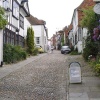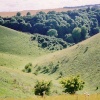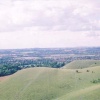Please login or click here to join.
Forgot Password? Click Here to reset pasword
 |  |  |  |  |  |
| Karen Pugh Posts: 858 Joined: 21st Dec 2006 Location: UK | quotePosted at 08:48 on 13th November 2007 I was out in my home town recently and the mist was lying low in the fields. Anyways I tried to take photo's and couldn't get what I wanted. I'm using a Nikon Coolpix P1 and tried many of the settings but it just wasn't happening. Can anyone help me? |
Gemm Ferrane Posts: 36 Joined: 12th Dec 2006 Location: UK | quotePosted at 22:28 on 13th November 2007 Camera often tends to under-expose fog/mist scenes. Is this what was happening to you? It's because the scene is so white and bright, the camera wants to make it darker. I normaly use exposure compensation to remedy this. You often need to over-expose it by 1 stop or so. Or use manual setting to adjust the exposure yourself. Hope this helps. :) |
| Karen Pugh Posts: 858 Joined: 21st Dec 2006 Location: UK | quotePosted at 08:50 on 14th November 2007 Thanks for the tip, I will have a go next time the weather is right |
Posts: Joined: 1st Jan 1970 | Gemm is perfectly correctly. What you are probably experiencing is an under-exposure problem. The problem is that a camera's exposure meter takes the full range of light in a scene and reduces it to an average grey tone. So anything lighter than standard grey gets under-exposed and shadows are given additional exposure to retain detail. Unlike the human eye, standard photographic film and modern photo cells in digital cameras can only record a specific range of light sources, so you need to be aware of what range your camera can record. Then, when this range is exceeded, you can 'bracket' your shots to ensure you record a full range of tones that can be combined to produce a final result. In order to do this, you first need to 'zero' your camera. This is easy with a modern digital camera set to 'manual' and suitable software. First, create a 'grey' card on your computer screen using your photo software. You want to produce a mid-tone grey which has RGB values of 127 decimal for each primary colour with a range of 0..255. Display this colour in full-screen mode and then prepare to take its picture (just the grey) with your camera mounted in front of the screen on a tripod. Fill your frame with the colour (you don't have to worry about focus) and use your camera's meter (in manual mode) to set the 'perfect' exposure. Take a callibration shot which should print perfectly as the mid-tone grey you have photographed. Now take a series of shots which become progressively underexposed until they render as solid black with no detail. Take another series which become progressively overexposed until you achieve solid white with no detail. (You don't really have any detail to examine in your photographs; but you will see where the change occurs because the subsequent shots are exactly the same as the solid white or black approached in the series). You are now in a position to analyze the exact EV range that your camera can record. (The range is the series from - but not including - the first solid black through to the first solid white - but not including it). Make a note of the range (in EVs) for future reference and make use of it in all your future photographs. Put your camera, if possible, into 'spot metering' mode. Then, before you take your next photograph, measure the brightest and darkest tones seperately. If their range is within your camera's capabilities, set your exposure to the middle value and shoot. You will have a perfect photograph with a full tonal range that you can be proud of. And, in your photo software, you will then have the ability to change the photo's mood significantly by just modifying its brightness. If you find that the scene before you exceeds the tonal range of your camera, you will need to get your tripod out and take two or more separate exposures so you can record the full tonal range of the image. Then, by using suitable software, you can combine the images to produce a single photograph which exhibits the full tonal range. This is a lot easier in digital photography than it used to be in the darkroom (when you used to be hampered by the limited tonal range available in different photographic papers). I personally use PhotoImpact to produce these types of results because it is a breeze. But you can extract similar results (with a little more work) using other offerings. Hope this helps...
|
Richard Foord Posts: 5 Joined: 15th Jan 2007 Location: UK | quotePosted at 11:13 on 17th March 2008 I am sorry but all this is totally unnecessary complications, just over expose by 1 to 2 stops and you should be find. A bit of back lighting also helps to bring the mist to life. See an example under Headcorn Kent. |
| Karen Pugh Posts: 858 Joined: 21st Dec 2006 Location: UK | quotePosted at 12:23 on 17th March 2008 Wow - thanks alot, it will take me a couple of months to sort this out ha ha. Richard I will try yours first I think. Karen |
Richard Foord Posts: 5 Joined: 15th Jan 2007 Location: UK | quotePosted at 13:11 on 17th March 2008 Go my way, you will be fine. I have been a pro photographer for forty four years and although theory is necessary, experience is far more important. I might add that the theory given in the prevoius post is not accurate and would not help at all. You would be better off selecting automatic on the camera than following that route. As the saying goes a little knowledge is a dangerous thing. If I am wrong in criticising lets see an example of the work that this theory has produced. |
| Paul Hilton Posts: 2605 Joined: 21st Nov 2004 Location: UK | quotePosted at 10:07 on 6th April 2008 Just took a snow scene this AM with a very sophisticated metering system on my d-SLR that promptly made the whole scene about 18% grey. Over-exposing the auto-metering by 2 stops--as Richard mentioned---soon had the snow scene back to white again. The camera's histogram on the original photo showed an image made up entirely of mid-tones only--nothing remotely white in it-- another way of quickly showing if there is something very wrong about the exposure of a picture just taken, if your camera has it. |
| Ruth Gregory Posts: 8072 Joined: 25th Jul 2007 Location: USA | quotePosted at 02:51 on 22nd June 2008 Re: the anonymous posting above. Was someone other than Yasser having technical difficulties with their avatar and date? Obviously the reply wasn't typed by him. I hear the theme from the Twilight Zone again. lol |
| Jo Adams Posts: 231 Joined: 23rd Sep 2006 Location: UK | quotePosted at 14:32 on 22nd June 2008 Just thinking the same thing Ruth |